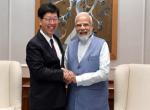Perhaps no other head of Indian state has displayed such a keen and well informed interest in space activities as Prime Minister Narendra Modi. Indeed, Modi who went round the facilities at Satish Dhawan Space Centre (SDSC), the Indian space port in Srihairkota Island on India’s eastern coast, before witnessing the spectacularly successful flight of India’s four stage space workhorse PSLV (Polar Satellite Launch Vehicle) on June 30 left a deep imprint on the Indian space community by his pointed questions on the utility of the space technology for improving the life of the common man in the country.
But what made Modi’s visit to the launch site particularly memorable was his strong advocacy of the need for India to use its soft power based on space technology to “win friends and influence people”. While addressing a gathering of ISRO (Indian Space Research Organisation) scientists after the PSLV launch, Modi, in a rare display of statesmanship, called for sharing “the fruits of our technological advancement with those who don’t enjoy the same” Stretching this logic a bit further, Modi called upon the Indian space agency to take up an initiative to develop and deploy a satellite system dedicated to provide a range of services to the country’s neighbours belonging to SAARC (South Asia Association for Regional Cooperation).There is no denying the point that Modi wants to deploy Indian space technology as part of the diplomatic outreach of the country in all its manifestations. On another front, Modi also urged the space scientists to extend the services of India’s home-grown navigation satellite IRNSS (Indian Regional Navigation Satellite System).The first two satellites in the seven spacecraft IRNSS constellation being developed to end Indian dependence on US GPS system are already in place. As things stand now, the countries in India’s neighbourhood can easily access the potentials of IRNSS. For it is designed to provide coverage across 1500-kms beyond India’s geographical boundaries. Civil aviation, marine navigation, road transportation and disaster management are some of the areas that would stand to benefit from the potentials of IRNSS. Modi was quick and in his elements to point out that “India’s space programme is driven by a vision of service to humanity and not by the desire to power”. Touching upon international humanitarian dimensions of the nation’s space programme, Modi noted that India is already sharing satellite based natural disaster information with around thirty countries and the benefits of the telemedicine which was introduced for the first time in the country by ISRO more than a decade back are being made available to war torn Afghanistan whose health care infrastructure is not in fine shape as well as to the African countries.
Significantly, the INSAT communications and IRS earth observation spacecraft constellations being operated by ISRO are being routinely harnessed for a wide ranging purposes including disaster warning, tele medicine and tele education, crop forecast, water resources monitoring and mapping of natural resources. Indeed, India’s experience in exploiting the potentials of satellite technology for accelerating the pace of socio economic development is of immense relevance to the third world countries including the country’s South Asian neighbours.
Rightly, Modi’s view was that India’s advantage lies in the cost effectiveness of its high performance satellite systems. By all means, a dedicated SAARC satellite is a brilliant master stroke by Modi to leverage space diplomacy and further Indian interests in the immediate neigbhourhood. A vastly stepped up regional cooperation in space technology stands out as an additional dimension to the prevailing conventional level relationship for jointly tackling the problems of poverty, backwardness and natural disasters haunting SAARC nations. According to Modi, this satellite can be an Indian “gift to the neighbour” and it should provide a full range of applications and services to all of India’s neighbours. Elaborating on the relevance of an exclusive SAARC satellite, Modi states,”There is a lot of poverty in the SAARC nations and we need scientific solutions for this. It will be beneficial for the development of all the countries in the region.” Spelling out his vision for India’s fast advancing space program, Modi had to this to say, “India is rooted in the age old ethos of Vasudhaiva Kutumbakam (the world is one family)“. In keeping with this age old philosophy, India, says Modi, should help the countries in SAARC region with the offer of its space technology specifically tailored to meet the needs of development in a cost effective manner.
Indeed, Modi’s commitment should be a starting point for ISRO to initiate discussions to get inputs on the specific needs of the South Asian nations in terms of the satellite based services they are keen on having. By all means, a satellite that India could fund and build for regular use by its South Asian neighbours is an idea worth pursuing. Needless to say, this satellite will encase the long standing experience of ISRO in exploiting the advances of space technology for “down to earth applications”. On another front, a SAARC satellite could to some extent weaken the punch of Chinese space diplomacy in the countries located in India’s immediate neighbourhood.
In the fifteen years since India starting offering the services of PSLV for orbiting satellites of international customers on commercial terms, as many as 40 satellites of 19 countries have been hoisted into space from the Indian soil, deploying this world class launcher. But then India would need to fast-track the developmental flights of the three stage, heavy lift GSLV (Geosynchronous Satellite Launch Vehicle) which had its successful debut mission in January this year, to expand the scope of the country’s commercial launch service. ISRO is now looking at the realization of high performance GSLV to get into the big league of launching communications satellites weighing more than two tonne. Modi left none in doubt that he wanted India to be a major player in the multi billion dollar global market for launching satellites for a fee.
Indeed, the successful June 30 flight of PSLV which simultaneously delivered five foreign satellites – 714-kg.French Spot-7, 14-kg.AISAT from Germany,7-kg.Velox –I from Singapore as well as NLS7.1 and NLS 7.2 each weighing 15-kg. from Canada— into their intended orbits has once again reaffirmed the multi mission capability of this highly reliable Indian space vehicle. “Today’s launch of five foreign satellites is global endorsement of India’s space capabilities” said Modi. In fact, PSLV had created a sort of history by successfully launching India’s first ever probe to Mars ‘Mangalyaan’ on November.5, 2013. It was an augmented version of PSLV which did the job of orbiting ‘Mangalyaan’. A similar variant of PSLV was pressed into service for launching India’s first ever lunar spacecraft Chandrayaan-1 in 2008.Way back in April 2008, PSLV had created a sort of world record by launching as many as ten satellites in one go.
Modi is fully well aware that in the context of China spreading its net of influence across South Asia through an alluring package of space cooperation, India cannot afford to remain silent. All said and done, Indian space diplomacy initiative as outlined by Modi assumes significance for the simple reason that China is surging ahead with its “string of pearls” and “maritime silk route” strategies to woo India’s neighbours. As it is, during his recent visit to Bhutan, Modi had offered this “Dragon Kingdom” Indian space expertise for speeding up the pace of its socio economic development. Nepal which shares cultural, spiritual and religious heritage with India is reportedly looking at China to give a practical shape to its proposal for a satellite system. Of course, India is also on the Nepalese radar in so far as acquiring a space system is concerned. As it is, Nepal would like to launch the satellite through a joint venture of national and international partners along with the Government of Nepal. India can easily offer Nepal a range of satellite based services as the footprint of Indian spacecraft constellations covers Nepal. Since Nepal’s geographical stretch is not as huge as India, it may not require a fully owned dedicated satellite system. Here India should play its card smartly by offering this Himalayan country an attractive technological package involving the offer of satellite capabilities for a variety of end uses at an affordable cost.
Similarly, Maldives with which India boasts of a long and cordial relationship, seems to be inching closer to China to meet the needs of its satellite resources. There are reports to suggest that India had failed to step into meet the needs of Maldives. Last year, Maldivian Government has said that India had not responded to its tender for a domestic spacecraft system. China, whose IT and telecom companies, are poised to make deep forays into this island nation is hoping to bag the Maldivian satellite order. For India, till now the elephant in the room was the limited launch capability based on the single operational vehicle in the form of PSLV .But now with the high performance GSLV poised to enter service following a couple of developmental flights, ISRO will be in a position to launch a communications spacecraft weighing upto 2.5-tonne.Perhpas this lack of launch support discouraged ISRO from contesting for the Maldivian satellite construction bid. And here again India can offer alternative, affordable satellite resources use plan based on the needs of this Indian ocean island nation. And like Nepal, Maldives too may not need a dedicated satellite to meet it needs. As such, India should look at the possibility of making available to Maldives, a portion of the capabilities built into Indian satellite constellations.
But then what could upset India is the move by the neighbouring Bangladesh, whose emergence as an independent country owed much to India, to invite China Great Wall Industries Corporation (CGWIC), the commercial arm of the Chinese space programme, as a “potential provider” of the satellite system. The Request For Proposal (RFP) floated in 2011 by telecom regulator of Bangladesh seeks to get a domestic communications satellite named “Bangabandhu” launched. In the context of the changed Indian political landscape and the advances ISRO is poised to make in the area of launch vehicle technology, India should give Bangladesh an innovative offer focussing on a package deal for a domestic satellite.
Of course, in Sri Lanka, India can do very little as the Colombo based space technology enterprise Supremesat has already entered into a US$215-million deal with CGWIC for the in orbit delivery of Supremesat-II satellite. As per the contract, the Supremesat-II will be launched at the head of a Long March vehicle in 2016. Meanwhile, SupremeSat-1 built by West European space enterprise Thales Alenia was launched by means of Long March rocket in 2011. Supremesat-1 is considered China’s co branded satellite. This satellite is being operated by the privately owned Supremesat in association with China satellite Communications Company. The relationship that China has forged with Sri Lanka in the strategic area of space cannot but be a matter of concern for India. For Sri Lanka forms an important link in China’s “String of Pearls” policy meant to encircle India. This satellite deal has all the potentials to strengthen Chinese position in the Indian Ocean region
Towards further east to Bangladesh, China has signed a satellite and ground systems contract with Laos. China had also previously built and launched communications satellites for Pakistan, Turkey and Nigeria. According to CGWIC, there are additional satellites in works for Sri Lanka, Turkmenistan and Belarus. The Chinese political leadership in Beijing looks at its space forays as a platform to strengthen its diplomatic and political clout and expand its business interests by offering assistance to the third world countries keen on entering space age.
Looking beyond Asia, Chinese space diplomacy has made inroads into Latin America. The successful launch of a Bolivian satellite by a Chinese space vehicle in December 2013 is considered a landmark in Beijing’s quest to project its software in Latin America through space technology. This US$300- million satellite dubbed TkSat-1 which was built by China Aerospace Science and Technology Corporation (ASTC) will support broadcasting, education and health care in Bolivia. Bolivia is also looking at China for partnering in a remote sensing satellite project planned for launch in 2017. Ivan Zambrana, Director of the Bolivian space agency, describes China as a world class space power.
China also has long standing space cooperation with Brazil and China-Brazil earth resources satellite programme took off in 1999. The latest satellite under this programme CBERS-3(China Brazil Earth Resources Satellite) which was launched in 2013 was lost in space. An identical CBERS-4 as a replacement to CBERS-3 is planned to be launched sometime during the year. And under Brazil-China space cooperation programme, it is planned to build a laboratory for studying space weather.
Right now the biggest stumbling block in the way of India in entering the market for building and launching satellites is the dependence of the country on a single operational launch vehicle in the form of PSLV. Of course, the high performance GSLV and its scaled up version GSLV-MKIII are under development. While GSLV will be available for routine operational use in around an year’s time from now, GSLV-MKIII should be ready for service in a couple of years time. On the other hand, China has at its disposal a wide range of launch vehicles in various configurations designed to deploy satellites in varying weight class into the required orbital slots. Moreover, India, unlike China, has to start from ground zero in so far as building a custom made satellite and arranging it in orbit delivery for an international customer is concerned.
Antrix Corporation, the Bangalore based commercial arm of the Indian space programme, is yet to build and launch a custom built satellite under a package deal for a third world country. Moreover, China boasts of three landlocked launch centres and one coastal space port to take care of a variety of launch needs with a short turnaround time. In distinct contrast, India has only one space port at Sriharikota Island. Added to that the industrial support available for the Chinese space programme is quite substantial even as Indian industries are yet to graduate to the position of taking up the challenge of building and supplying launch vehicle and satellites in a ready to use condition. In the ultimate analysis, ISRO should launch a multi faceted initiative to boost the prospects of India in the multi billion dollar space global market. Here the Narendra Modi government should think of launching a national mission to create a vibrant Indian space industry that is in no way inferior to its global counterparts.
Published Date: 5th August 2014, Image source: http://news.bbcimg.co.uk








Post new comment